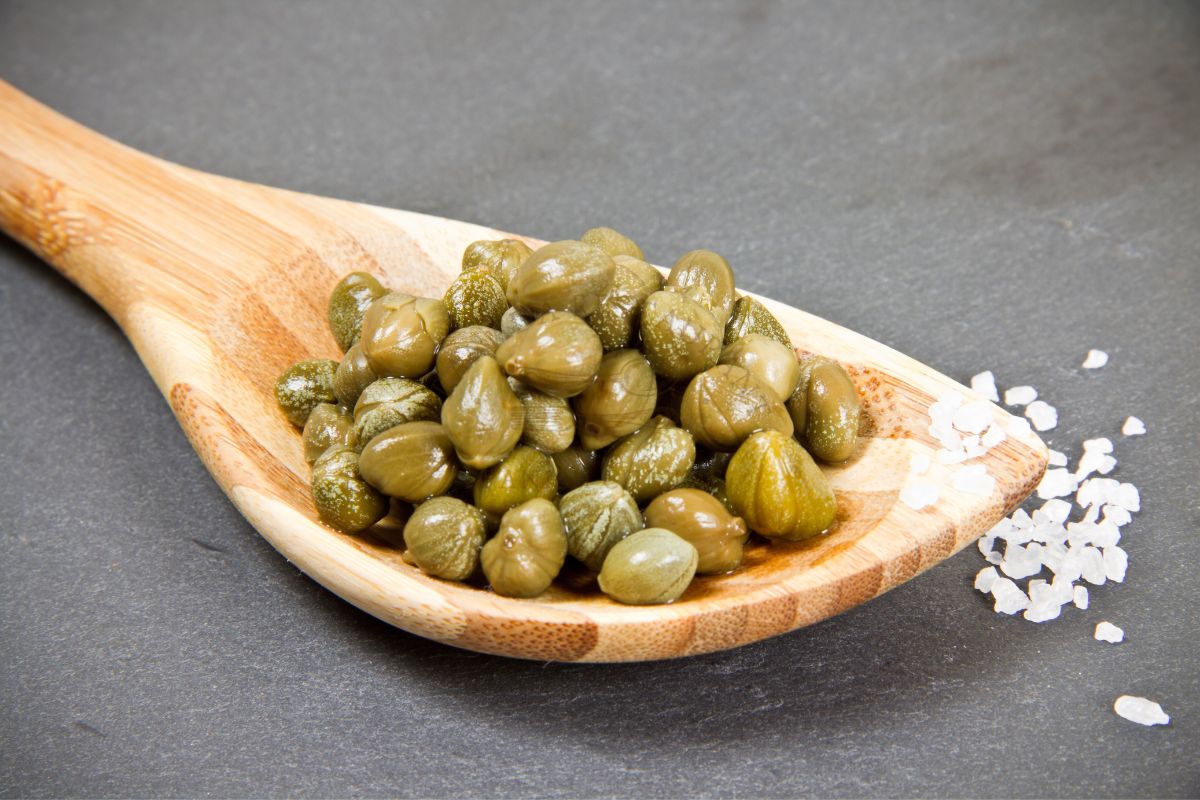For cooks who enjoy making dishes with a little something extra, there is perhaps no better ingredient to use than capers. Tart and briny capers can bring an intense burst of flavor to even the simplest dish – but just as important is knowing which kind of caper to use. Capote vs nonpareil capers?
Choosing between these two types can seem daunting for anyone unfamiliar with their unique attributes. In this blog post, I’ll share my knowledge about these two popular varieties and help you determine which one will work best for your recipes!
Quick note:
The most significant differences between capote and nonpareil capers are their size, flavor, and texture.
- Nonpareil capers tend to be smaller and have a milder flavor, while Capote capers are larger and have a more intense briny flavor.
- Capotes have a softer texture that can be mashed easily, while nonpareil capers are crunchier and hold their shape better.
What Are Capers?
They are small, olive-like buds from the caper bush that have been pickled in a brine solution. Capote and nonpareil are two distinct varieties of capers. They are commonly used in Mediterranean cuisine.
Capote Capers
What are capote capers?
These small, olive-like berries are native to the Mediterranean region. Capote capers, also called “salt-packed” or “brine-packed,” are the larger of the two varieties. These capers measure between 1/4-inch and 1/2-inch in diameter and have a more intense flavor than nonpareil capers.
They have a tart and briny flavor that is slightly less intense than nonpareil capers. The taste of capote capers makes them perfect for adding a subtle burst of flavor to dishes without overwhelming other ingredients.
Geographic origins of Capote capers

Capote capers grow wild in the Mediterranean region, including Italy, Greece, Spain, and Turkey. They are harvested during the summer months when they reach their peak flavor.
Uses for Capote capers
The mild flavor of capote capers makes them ideal for adding to dishes that require a subtle burst of flavor. They can be used to add flavor to salads, sauces, soups, and more. They can also be pickled and served as a condiment or side dish.
The main disadvantage of capote capers is that their mild flavor may not stand up well to stronger-tasting ingredients.
Find out: Get a Taste of Spain: The Authentic Flavors of Tapas Bars
Nonpareil Capers
What are nonpareil capers?
Nonpareil capers are small, olive-like berries native to the Mediterranean region. They, also known as “vinegar-packed,” are much smaller than capote. These pea-sized, petite buds have a milder flavor and a softer texture than their larger counterparts. They can add an interesting visual element to dishes.
Origins of nonpareil capers
Nonpareil capers grow wild in the Mediterranean region, including Italy, Greece, Spain, and Turkey. They are also harvested in the summer when the flavor is at its peak.
Uses for nonpareil capers
Nonpareil capers are a popular choice for adding bold flavor to dishes. They can be used in salads, sauces, soups, and more. They can also be pickled and served as a condiment or side dish.
The one thing you should consider when using nonpareil for your dishes is that their intense flavor can overpower lighter-tasting ingredients.
Comparison of Capote and Nonpareil Capers
The main difference in comparing capote and nonpareil capers lies in their flavor, texture, and size.

Flavor
Capote capers have a milder, less intense flavor than nonpareil capers. Additionally, nonpareil capers are slightly larger in size than capote capers.
Capote capers are often pickled for longer, giving them a saltier taste, which accounts for the difference in flavor. Therefore, they might be an excellent choice for meals when you want the flavors of the other components to stand out.
Texture
Capote capers are bigger and more strong, whereas nonpareil capers are tiny and more delicate.
This is because nonpareil capers are usually picked before they flower, while capote capers are usually picked after they have flowered.
Capote capers have a softer texture, while nonpareil capers have a firmer texture. This can make a difference in dishes where you want the capers to stay intact and contribute flavor without becoming too mushy.
Size
Nonpareil capers are smaller than capote capers, so they may be a better choice if you want to save on costs or don’t want too much of a briny flavor.
Capote capers can measure up to two or three times as large, so if you need more of a briny flavor and are looking for a bit more bulk, capote capers may be the way to go.
The price of the two types of capers can also vary, with nonpareil capers often being more expensive due to their smaller size and higher demand.
How Do the Two Types of Capers Differ in Specific Dishes
Salads
In salads, the milder flavor of capote capers may be preferable if you don’t want an overly strong taste. Nonpareil capers can provide a stronger flavor and work well in dishes where their boldness won’t overpower other ingredients.
Read More: From Valencia to Your Plate: The History of Paella Rice
Soups
For sauces or soups, nonpareil capers are a great way to add flavor without making the dish too salty. Capote capers may be more appropriate for dishes where you want the briny taste to come through and can stand up to stronger flavors.
Pickling
In pickling, nonpareil capers will give you a bolder flavor since they are smaller and can absorb more of the brine. Capote capers, on the other hand, maybe a better choice for when you want to pickle something but don’t want it to be as salty.
Capers Nutrition Facts
Three mains things you’ll get from capers:
- Antioxidants
- Fiber
- Sodium
These tiny green buds are delicious and contain antioxidants that help protect against oxidative stress, which can reduce cancer risk.
Plus, 1 ounce of capers gives you 1 gram of fiber – great for increasing fiber intake without extra calories.
And in terms of sodium, one tablespoon of capers provides 16% of the daily recommended amount.
FAQs
Is it necessary to cook capers?
No, capers do not need to be cooked. They can be used raw in dishes or pickled for additional flavor.
Do I need to rinse capers before use?
It is a good idea to rinse capers before using them in recipes, as they can have an overly salty flavor.
Can I use both types of capers interchangeably?
Yes, you can use both types of capers interchangeably depending on the dish and desired level of saltiness and flavor.
Do capers need to be refrigerated?
Yes, it is recommended that you store capers in the refrigerator to extend their shelf life. They can also be stored in a cool, dark place. When properly stored, they should have a shelf life of up to 2 years.
Are there any health benefits associated with consuming capers?
Yes, capers are a good source of antioxidants, fiber, and vitamins. They also contain compounds that may help reduce inflammation and aid in digestion. They can also be used to add flavor without extra calories or sodium. Therefore, they are a great addition to any healthy diet.
Are there any substitutes for capers?
Olives, caperberries, and gherkins are all good substitutes for capers. They all have a similar briny flavor and can be used in place of capers in dishes.
However, their texture may not be as crisp as capers. Additionally, anchovy paste or pickled jalapenos could also provide a similar flavor.
What are some recipes that use capers?
Capers can be used in a wide variety of dishes. Some popular recipes that use capers include:
- Caesar salad
- Tartar sauce
- Pasta salads
- Pan-seared salmon
- Steak with caper butter
They can also be used to make delicious sauces such as salsa verde, gremolata, and puttanesca.
Additionally, capers are often used in Mediterranean dishes such as hummus and tabouli.
Check out This Video for Capers: Health Benefits and How to Prep Them
Capote and nonpareil capers are two types of capers commonly used in cooking. They vary in size, texture, and flavor. Capote capers are larger with a stronger flavor, while Nonpareil capers are smaller with a milder flavor.
Both types have advantages and disadvantages, depending on the prepared dish. When choosing which type of capper to use in a recipe, it is important to consider the desired outcome for the dish.
Further Reading:

I am Benjamin Nunez, and I love Spanish food, Italian food, and seafood. I have worked in kitchens all my life. I started as a dishwasher when I was just a teenager, and worked my way up to being a head chef.
I specialize in Spanish cuisine, but I can make any kind of Italian or seafood dish you want. My kitchen is always open! Website: https://granadarestaurant.com/

